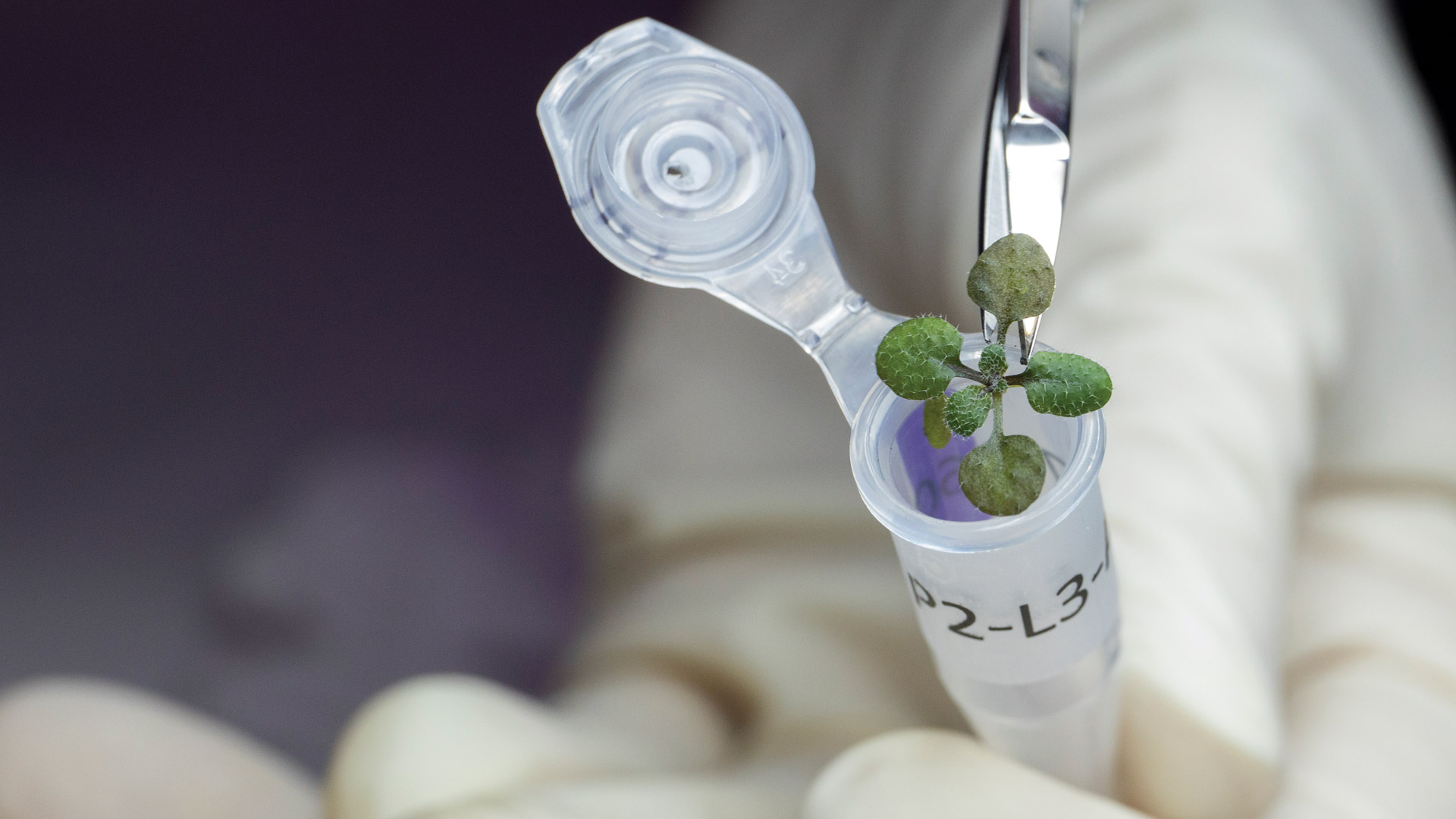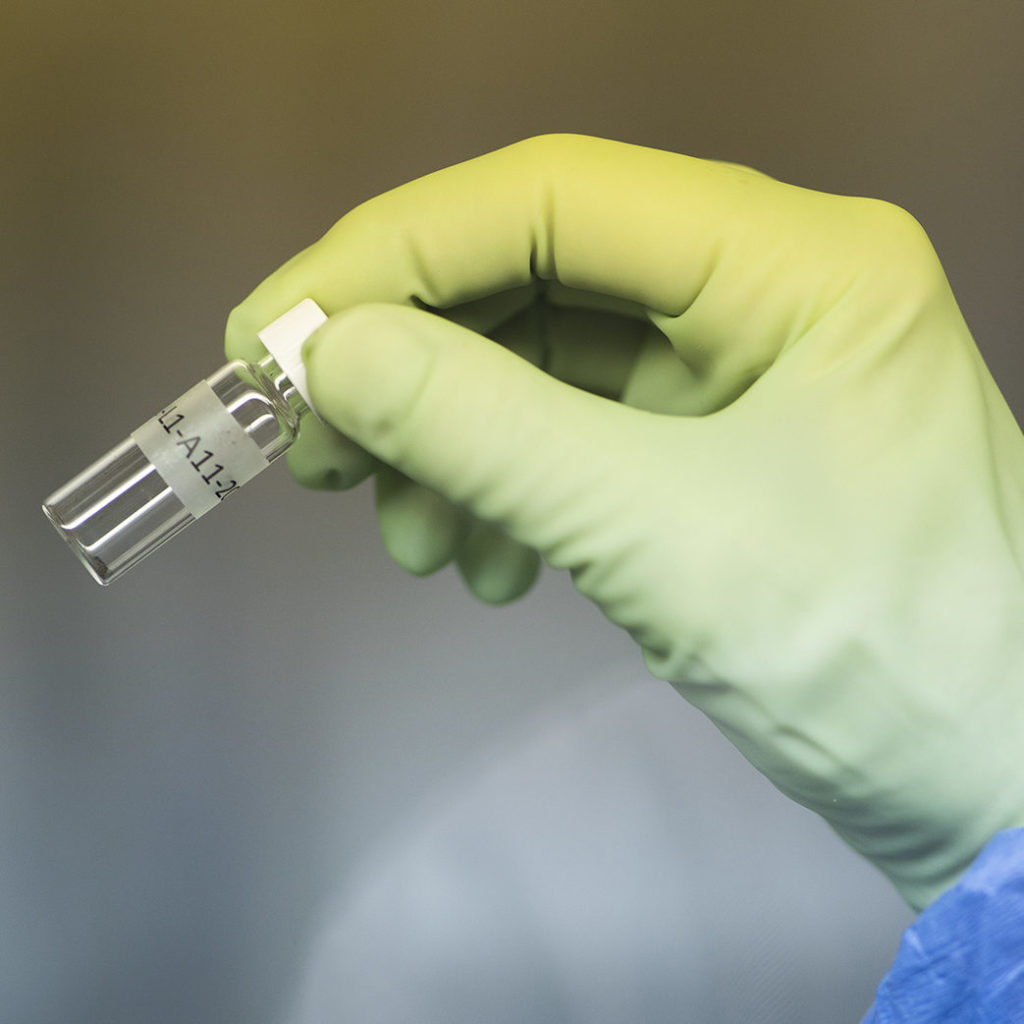A safe seems an unlikely place for a box of soil. Unless it’s the rarest, most valuable
soil on Earth.
So when 12 vials — each with a gram of lunar soil collected during the Apollo 11, 12 and 17 missions to the Moon — arrived at the UF Space Plants Lab early last year, researchers Rob Ferl and Anna-Lisa Paul wasted no time getting them secured.
“Every discussion we had with NASA was about safety and security for these samples,” says Ferl, a distinguished professor of horticultural sciences in UF’s Institute of Food and Agricultural Sciences. “So when they finally arrived, we were very nervous. When we opened the box, we just sat there for long minutes realizing we had some of the Moon in our hands. Then we got them in the safe.”
Ferl and Paul applied three times over 11 years for the chance to work with this moon dust. Finally, NASA said yes.
“We were stunned, elated, excited,” says Paul, also a horticultural sciences professor in UF/IFAS. “You might say we were over the Moon.”
Ferl attributes the long-awaited green light partly to the Artemis Program, which plans to return astronauts to the moon. Artemis will require a better understanding of how to grow plants in space, Ferl says, “because it’s pretty clear that somebody is going to be growing plants on the Moon in the next decade.”
Ferl and Paul are trailblazers in the study of plants in space. Through the Space Plants Lab, they have sent experiments on space shuttles, on rockets to the International Space Station and on suborbital flights with Blue Origin and Virgin Galactic, all with the goal of understanding how plants respond to these extreme environments. Their findings may one day help astronauts grow plants as a source of food and oxygen on deep space missions.
But ever since their first spaceflight experiment, the researchers had dreamed about the chance to grow plants in soil that was not of this world.
“For longer missions, we may use the Moon as a hub or launching pad. It makes sense that we would want to use the soil that’s already there to grow plants,” Ferl says. “So, what happens when you grow plants in lunar soil, something that is totally outside of a plant’s evolutionary experience? What would plants do in a lunar greenhouse? Could we have lunar farmers? These are all things we want to know.”
To begin to answer these questions, Ferl and Paul proposed a deceptively simple experiment: plant seeds in lunar soil and see what happens.
Flight Tests
For plant scientists, germinating seeds in terrestrial soil is just another day in the lab. But for Ferl and Paul, lunar soil — which geologists call lunar regolith — presented new challenges and plenty of unknowns.
For one, they had just a few teaspoons of the stuff. Each particle is of incalculable scientific and historical significance. Lunar regolith is the powdery substance that covers most of the moon’s surface—Buzz Aldrin’s boot print, as seen in the now iconic photo, was made in lunar regolith.
“When the lunar samples came back to the Johnson Space Center in Houston, they were handled in a total vacuum. Initially, that’s because NASA didn’t know if lunar soil would be harmful to people; for example, if it had a new pathogen that had never been on Earth,” Ferl says.
“To test if there were pathogenic organisms on the moon, NASA sprinkled it on plants, though they weren’t growing them in the regolith. After a few weeks, scientists determined there was nothing dangerous about the lunar regolith and it was sealed up in vials.”
And now the Space Plants team was preparing to unseal those vials.
“The samples we were working with were collected by Neil Armstrong, Pete Conrad, Harrison Schmitt, and other astronauts from the surface of the Moon and brought back to Earth in the 1960s and ‘70s, and now we were opening the vials, exposing the samples to oxygen for the very first time,” says Paul, who is also director of UF’s Interdisciplinary Center for Biotechnology Research. “It was a daunting responsibility.”
The small amount of lunar soil meant the scale of the experiment had to be equally small. To grow their tiny lunar garden, the researchers used thimble-sized wells in plastic plates normally used to culture cells.
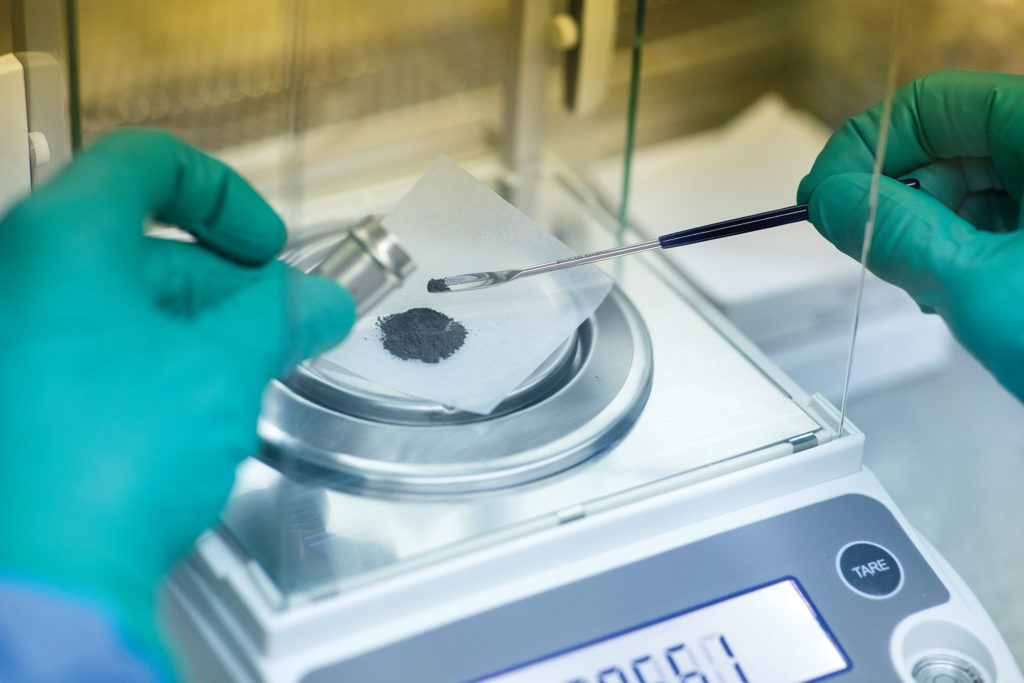
To further complicate matters, Ferl and Paul had to retain as much of the original samples as possible.
“These samples were on loan to us. We needed to send NASA back as much as we possibly could,” Ferl says.
Given all these constraints, the Space Plants team choreographed and practiced every motion of transferring the lunar samples into the plates and planting the seeds. In their practice runs, they used JSC-1A lunar simulant, a terrestrial substance that mimics the real thing.
Still, there was only so much practicing they could do.
“The simulant is just an approximation,” Paul says. “True lunar regolith is nothing like what we have on Earth. Under a microscope, terrestrial soil particles are rounded. Lunar regolith is sharp and jagged. It’s made up of ions and elements different from what you tend to find in soils on Earth. But, aside from these few knowns, there was a lot more we couldn’t predict about how the lunar soil would behave.”
On the other hand, a lot is known about the plant they would be growing, Arabidopsis thaliana. Arabidopsis is used widely in the plant sciences because its genetic code has been completely mapped. Ferl and Paul have used Arabidopsis for years on their space plant projects.
Using such a well-studied plant allowed the researchers to get a clear picture of how the lunar regolith affected the plants growing in it, down to their patterns of gene expression. To provide points of comparison, the researchers also grew Arabidopsis plants in the JSC-1A lunar simulant and simulated Martian soils, as well as terrestrial regolith from extreme environments.
“We wanted not only to observe how well the plants grew in the lunar samples, but how that environment changed them at the cellular and genetic level,” Paul says.
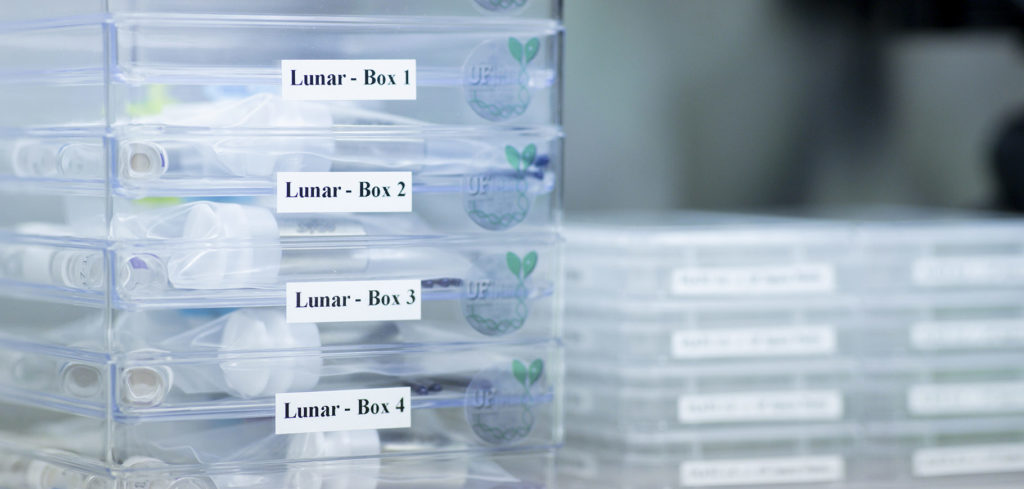
Countdown
After several practice runs with the lunar simulant, Ferl and Paul were finally ready to plant seeds in the real lunar regolith — or as ready as they were ever going to be.
“I’d sum up my feelings as ‘trembling excitement and awe,’ mixed with a bit of deep pride that we were now a part of the story and lineage of humans and Moon exploration,” Paul says.
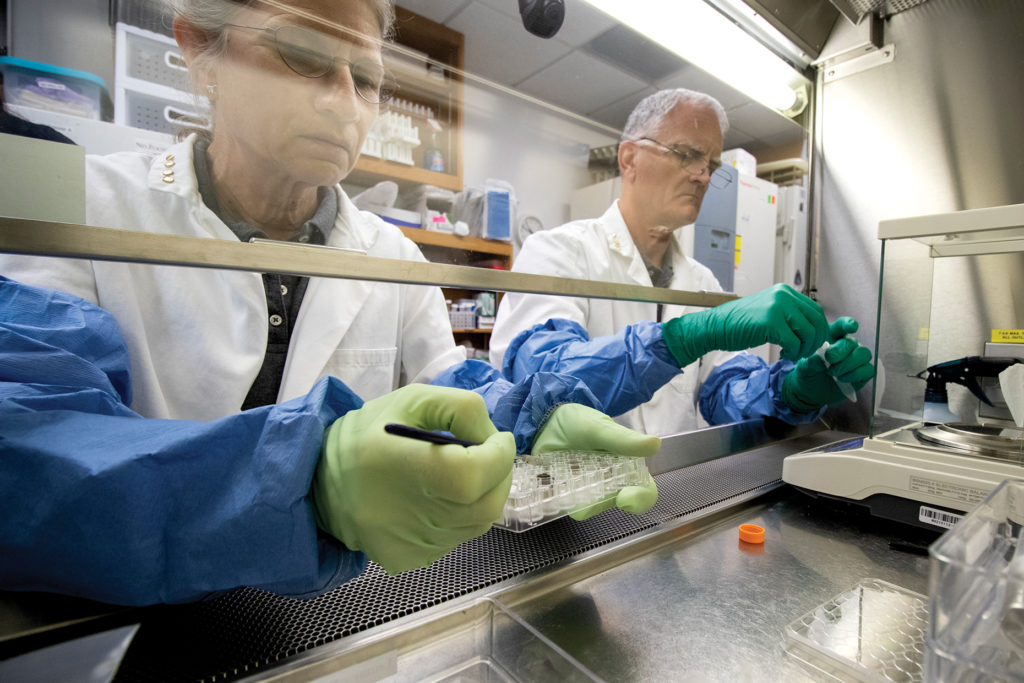
With a few graduate students looking on, Ferl and Paul went over the procedure one final time with Space Plants lab manager Jordan Callaham. During the procedure, Callaham would take detailed notes on a printed diagram showing which samples were going in which well, how much they weighed and other data.
In the corner of the room sat the dozen sealed vials, each holding precious Moon dust.
As Ferl and Paul got ready to open the vials under the lab hood, the room got quiet. The two scientists spoke to each other in low voices, requesting tools and asking questions as if they were surgeons. Some of the vials weren’t easy to open—think stuck pickle jar, but with an irreplaceable substance on the line.
“When I opened that first vial, my hands were visibly shaking,” Ferl says. “No way you can have the Moon in your hands for the first time and act anywhere like a normal human being, especially if you’re a geek like me. All you have to do is sneeze and you blow away the experiment.”
At last, the vial was open. Ferl scooped some of the soil onto a small metal spatula and invited the lab’s few onlookers to lean in.
“That right there is lunar soil,” he said.
Some of the lunar samples proved easier to work with than others. Because lunar soil is so jagged, static can build up, causing the substance to clump together uncooperatively.
“Apollo 17 samples were by far our favorite to work with. Those were collected off the lunar rover after its bumper broke — so they were almost accidental, in a way,” Ferl says.
It took about an hour to fill all the wells. Before the seeds could be planted, the soil needed to be moistened with distilled water. Each well had a circle of rockwool at the base to wick up moisture when the plate was placed in water.
Paul and Ferl placed the plates in water and waited. And waited. The non-lunar material was hydrating, but the lunar soil remained as dry as the surface of the Moon.
“Well, to be fair, they’ve haven’t seen water in a billion years,” Paul said with a nervous laugh.
But growing plants requires water. The scientists had to find another way to get the lunar soil to absorb it.
They turned to plan B: Fill a pipette with water and add the water drop by drop.
But instead of soaking in, the water formed perfect beads on the soil’s surface. In some instances, it even climbed back up onto the tip of the pipette.
“Look at that — it’s hydrophobic! It does not like water,” Paul said.
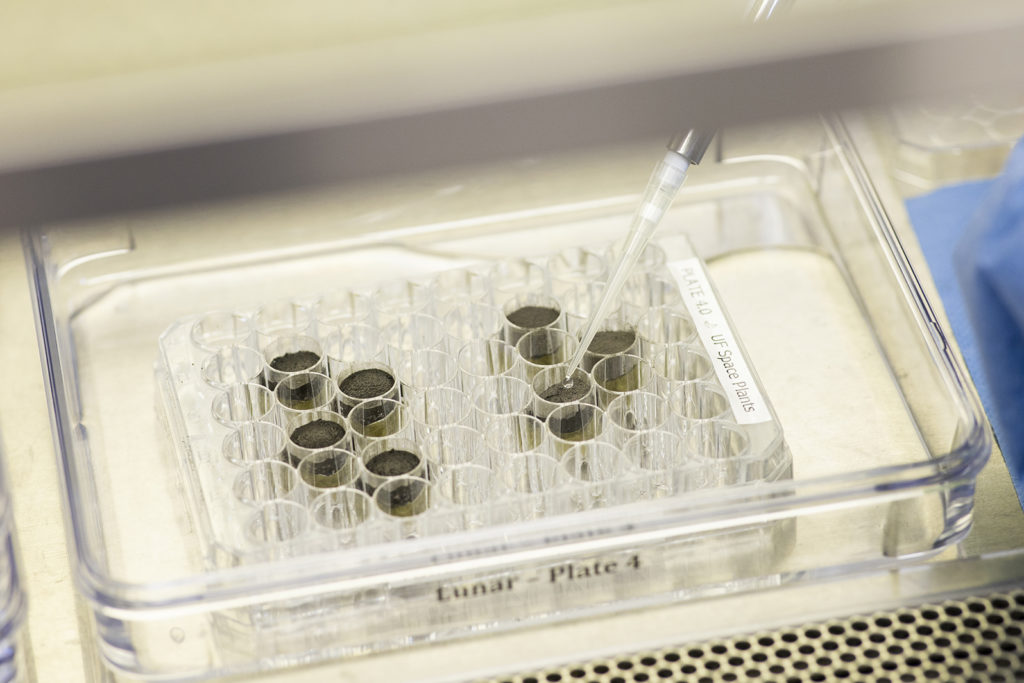
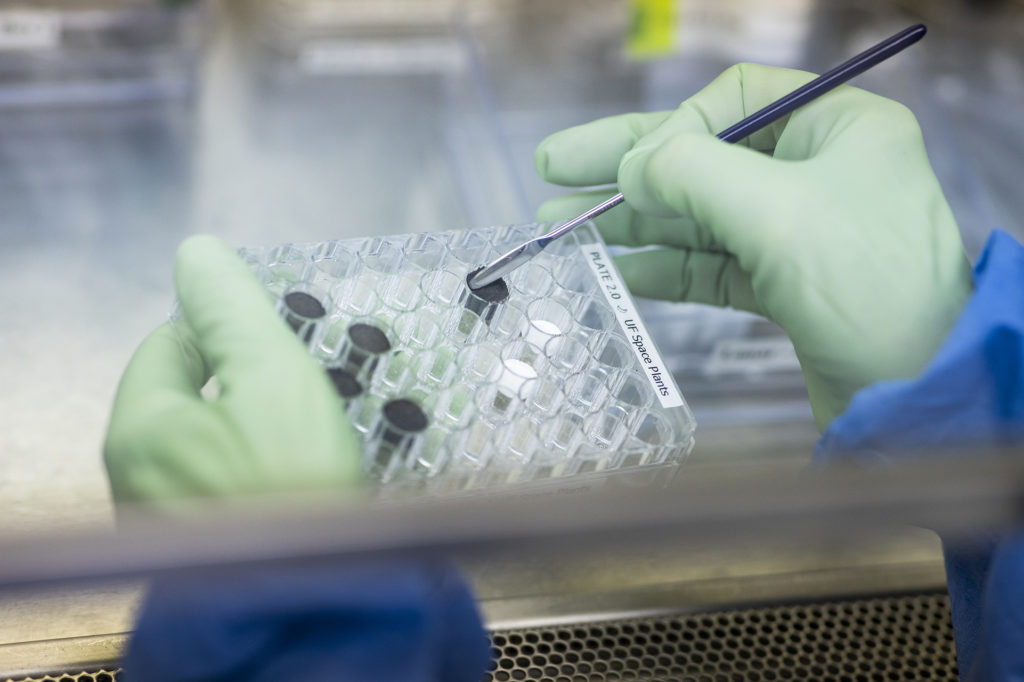
On to plan C: Mix the water into the soil with one of the small spatulas. It wouldn’t be ideal, though — mixing would mean precious grains of lunar soil could be lost.
But to everyone’s relief, mixing worked.
Ferl says that for biologists, regolith is considered soil “when there is biology in it,” so the Moon dust was about to become Moon soil.
Two to three Arabidopsis seeds were added to each well, and then the plates were moved to a nearby Growth Chamber Facility. There, in a small, climate-controlled room, the plates sat under timed LED lights, waiting to sprout the first plants of their kind.
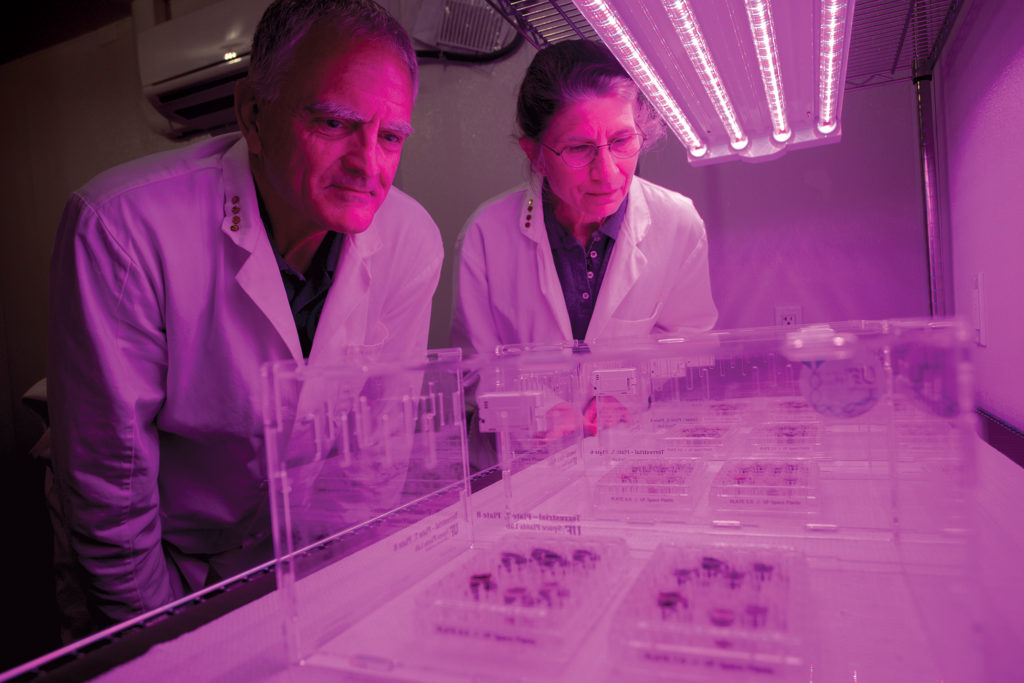
Liftoff
And sprout they did. Tiny Arabidopsis plants emerged from lunar and non-lunar soils alike. Nearly every seed germinated.
“We were amazed. We did not predict that,” Paul says.
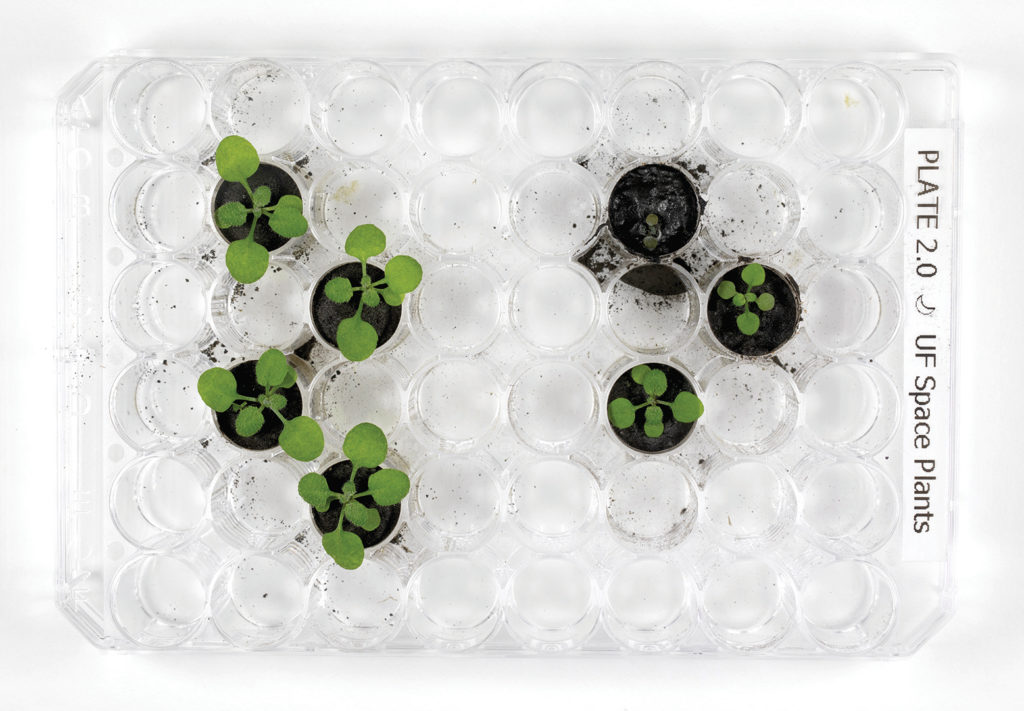
As Ferl and Paul explain in a study published in the journal Communications Biology, the results indicate that lunar soils don’t interrupt the hormones and signals involved in plant germination.
Daily care for the plants involved “fairly routine science protocols,” Paul says. Entering the space, the scientists cleaned their shoes on a sticky mat at the threshold and donned lab coats and gloves. Then they got to work taking pictures, measurements and notes, and giving the plants fresh water and nutrients.
“It was still an awe-filled operation, every day, realizing what we were doing, what we were touching,” Paul says. “But, as a scientist, you kind of step away from the overwhelming magnitude of the experiment because you need to treat all aspects of the experiment exactly the same — from the astoundingly precious lunar samples to the JSC-1A terrestrial controls.”
Between days six and eight, the plants were thinned so that only one plant would be left to grow in each well. To do this, Paul and Ferl went in with a magnifying lens and tweezers, plucking out the extra sprouts — a procedure no different than that undertaken by a farmer or home gardener growing plants from seed, but at a very small scale.
“It’s like tiny plant surgery,” Paul says.
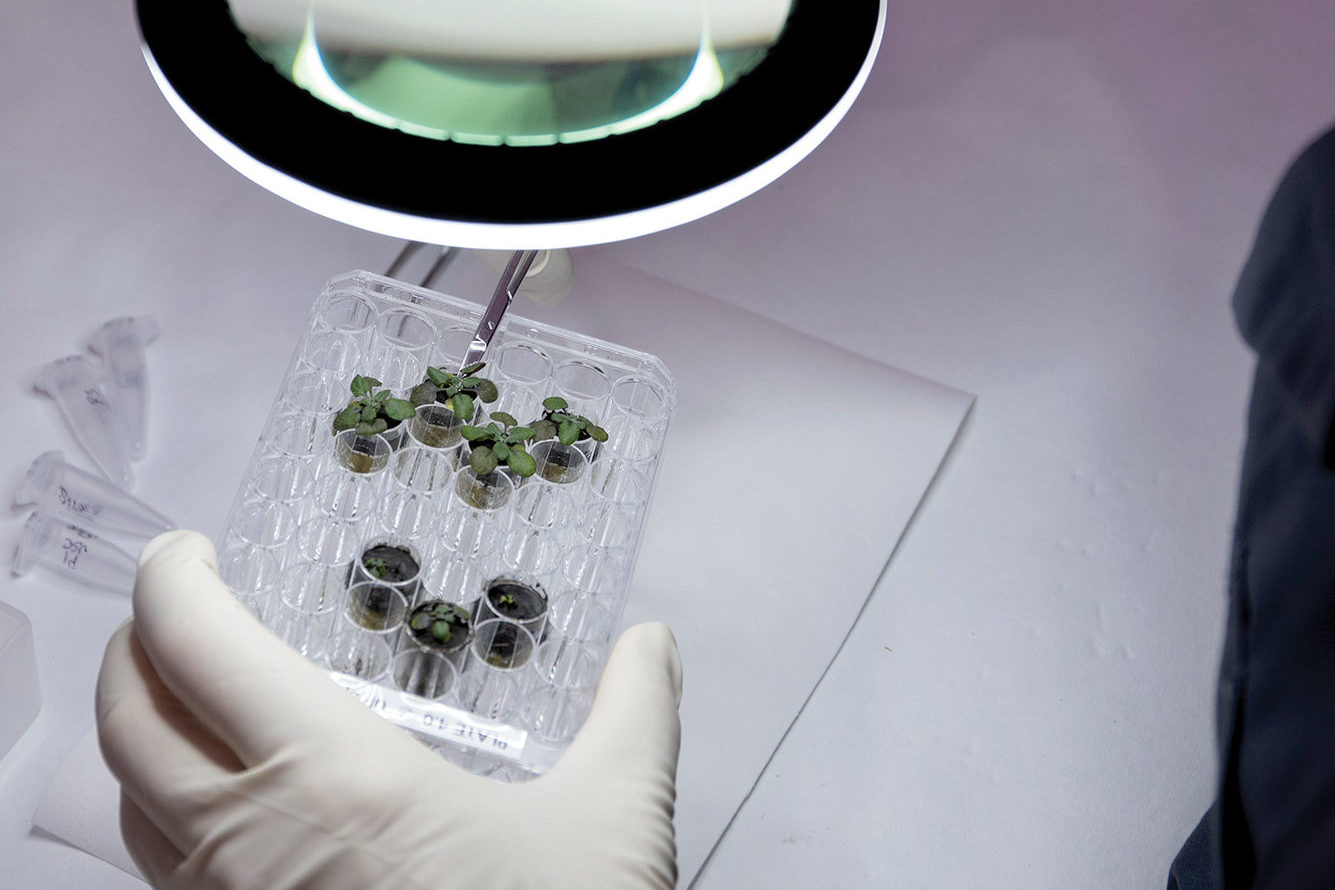

It was during this delicate process that the scientists first noticed that the plants growing in the lunar soil had smaller roots than those grown in the other media. As the remaining plants grew, the ones in lunar soil grew more slowly and had greater variability in size compared with the others. Some were visibly stunted.
These were all physical signs that the plants were working to cope with the chemical and structural make-up of the Moon’s soil, Paul says. This was further confirmed when the researchers performed gene expression analyses of the plants.
“At the genetic level, the plants were pulling out tools traditionally used to cope with stressors such as salt, metals and oxidative stress. Based on this, we can infer that the plants perceive the lunar regolith environment as stressful,” she explains.
Overall, the scientists say, the study reveals two things: Yes, plants can grow in lunar soil, but doing so successfully will require some tinkering.
The properties of the soils may play a role in how well the plants can grow, say Ferl and Paul, who collaborated on the study with Stephen Elardo, an assistant professor of geology in the UF College of Liberal Arts and Sciences.
For instance, plants grown in soils collected during the Apollo 11 mission fared worst. These samples were taken from mature regolith, the outer layer of the Moon’s surface, which is exposed to more cosmic wind than the layers beneath. On the other hand, plants grown in soil from Apollo 17, a less exposed regolith, fared better.
Growing plants in lunar soils may also change the soils themselves, Elardo says.
“Besides the success of plant growth, I’m interested in how the soil mineralogy changes in response to the plant being grown in it. The Moon is a really, really dry place, and the first time we were actually able to measure water in a lunar mineral was in 2010,” Elardo says. “So how will the minerals in lunar soil respond to having a plant grown in them, with the added water and plant nutrients? Will the mineralogy change? How much? Will adding water make the mineralogy more hospitable to plants?”
Follow-up studies will build on these questions and more.
“Ultimately we would like to use the gene expression data to help address how we can ameliorate the stress responses to the level where plants — particularly crops — are able to grow in a lunar regolith with very little impact to their health,” Paul says.
But for now, the scientists are celebrating having taken the first steps toward growing plants on the Moon.
“We wanted to do this experiment because, for years, we were asking this question: Would plants grow in lunar soil?” says Ferl. “The answer, it turns out, is yes.
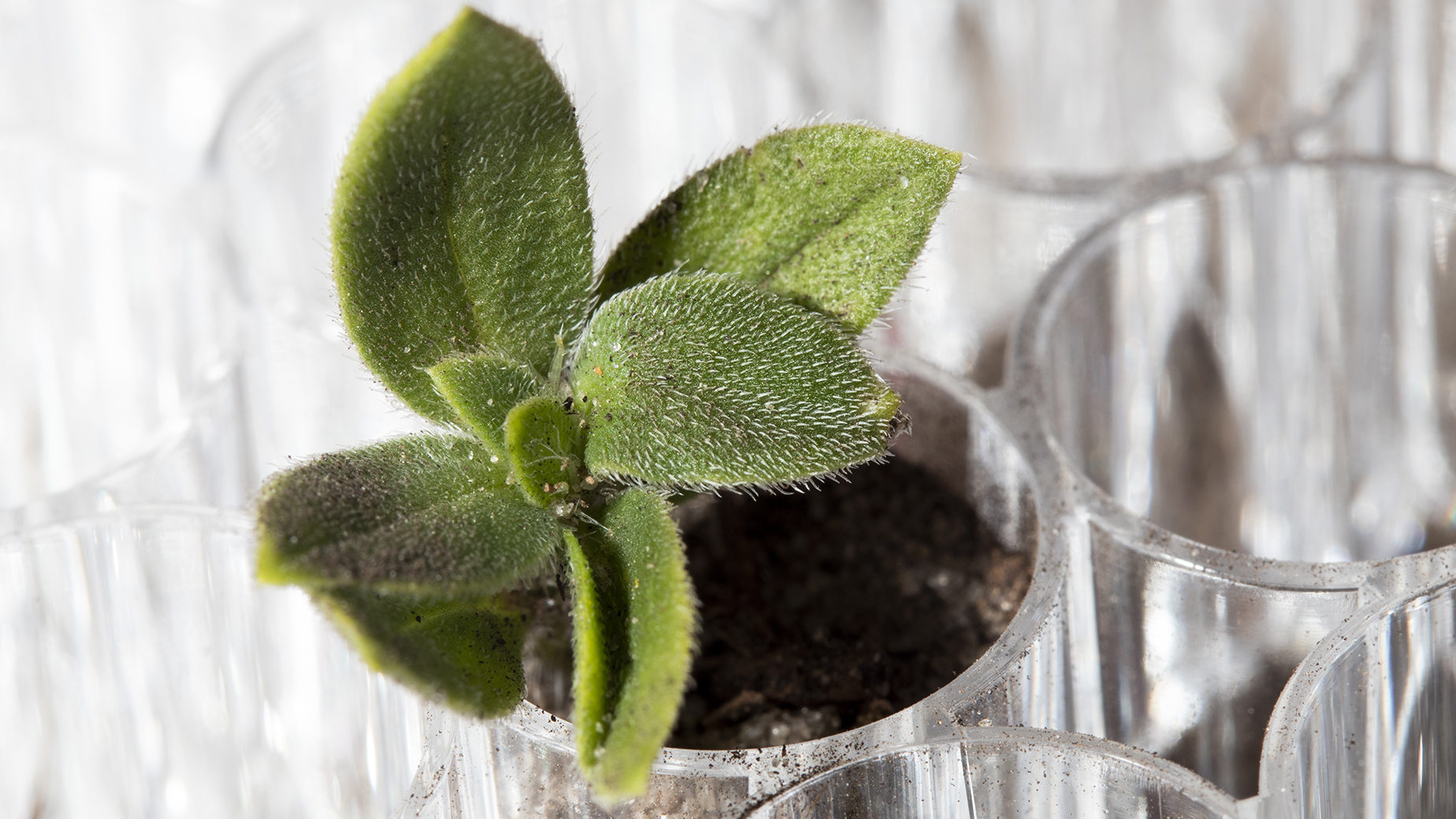
Sources:
Rob Ferl
Distinguished Professor of Horticultural Sciences
Assistant Vice President for Research
Anna-Lisa Paul
Research Professor of Horticultural Sciences
Director of the Interdisciplinary Center for Biotechnology Research
Stephen M. Elardo
Assistant Professor of Geology
Related website:
Hear the Story
The audio version of this story is available on our YouTube.

